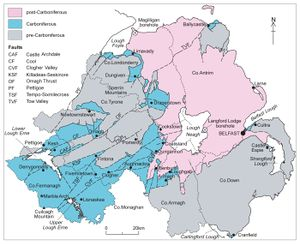Carboniferous of County Armagh, Northern Ireland
| Mitchell, W I (ed.). 2004. The geology of Northern Ireland-our natural foundation. Geological Survey of Northern Ireland, Belfast. |
W I Mitchell
Introduction




In the Carboniferous outcrop between Co. Fermanagh and north Co. Armagh (P947815) the component formations of the Tyrone Group (P947927) maintain their lithological integrity. However, in the rest of Co. Armagh the Carboniferous succession is thinner and is divided into two groups. With the exception of the Killuney Conglomerate and Carganamuck Limestone formations (P947819) details are available from the 359m deep Wilson’s Bridge borehole [1].
Tyrone Group
The unconformity with Ordovician rocks is exposed in the Killuney stream [H 896 461]. Late Tournaisian strata at the base of the Tyrone Group were deposited before and during a marine transgression and comprise the Killuney Conglomerate, Retreat Siltstone and Ballynahone Micrite formations (P947819). Two significant biostratigraphical events occur in the latter formation. The appearance of the miospore Lycospora pusilla marks the early Chadian and the foraminiferan Eoparastaffella simplex marks the base of the late Chadian and the Tournaisian-Viséan series boundary. The base of the TS Biozone in the Milford Mills Formation coincides with the appearance of the miospore Knoxisporites stephanephorus (P947819). The Oulart Villa Limestone Formation at Oulart Villa [H 897 469] contains the coral Dorlodotia pseudovermiculare and early Arundian foraminifera at the base, with D. cf. briarti and Siphonodendron martini and mid- to late Arundian foraminifera at the top. The base of the Drumman More Sandstone Formation is probably Holkerian, based on the presence of Lithostrotion corals and the foraminifera Paraarchaediscus at concavus stage. Near the top of the Formation the miospore Perotrilites tesselatus indicates the TC Biozone and a Holkerian–early Asbian age.
Armagh Group
The Armagh Group consists almost exclusively of marine, shallow water limestones with palaeokarst surfaces and reddish brown clay palaeosols. Although their use as building stone has declined it is still quarried for aggregate between Loughgall and Armagh (P947815). It is represented by three formations of late Asbian to Brigantian age (P947819).
The Wilson’s Bridge Limestone Formation in Rock Road quarry [H 871 434] shows evidence of reworking of soft sediment and benthic faunas as a 2 m bed of conglomerate composed of the colonial corals Lithostrotion and Michelinia and Siphonophyllia benburbensis. Limestone intraclast conglomerate and lenticular sandstone are exposed in a lane section at Annacramph [H 886 494]. Most limestone quarries in the area are developed in the Loughgall Limestone Formation using the distinctive pale grey to creamy white, coarse-grained bioclastic and oolitic grainstone.
The quarry section [H 878 498] in the Carganamuck Limestone Formation (P947819) contains Brigantian corals including Actinocyathus floriformis and Diphyphyllum lateseptatum [1] and the brachiopod Gigantoproductus